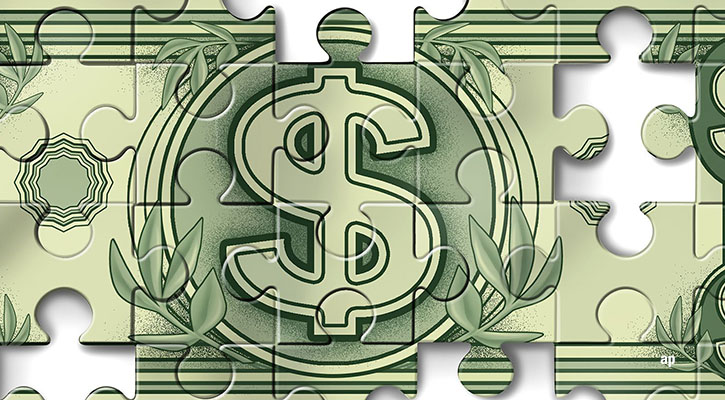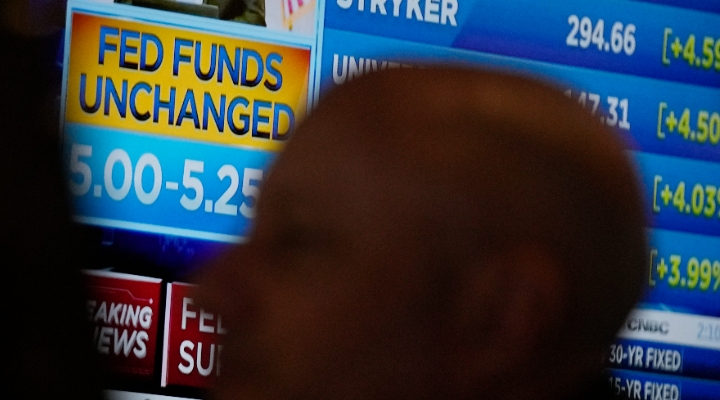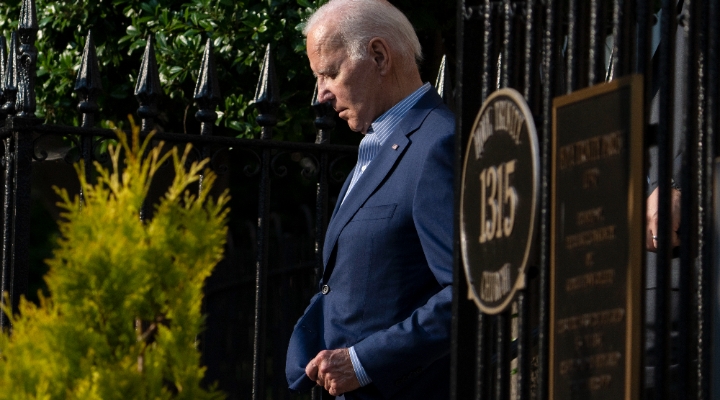
The U.S. dollar is the world’s reserve currency. That is unlikely to change anytime soon, even though some may think its status is declining.
Let’s look at some numbers. According to the IMF's COFER database, while the US dollar used to account for 72% of the world's central bank reserves, this has fallen to 58.4% by 2022. Eurizon SLJ Asset Management estimates that this drop, when exchange rates are taken into account, was actually 11 percentage points in 2022, lowering the US$ share to 47%.
“There's a downward trend in the dollar's status, and it's accelerating,” says Yanick Desnoyers, Vice-President, Economic Research, at Addenda Capital.
Only in the gigantic market for currency transactions does the $US reign unchallenged, being the counterparty currency in 88% of transactions, according to the Bank for International Settlements. This share has fallen by just two percentage points since 1988, when it was 90%.
In global trade transactions, the US$ retains the lion's share, even rising slightly from around 50% in 2000 to around 54%, according to a recent study by TD Economics. Meanwhile, in terms of international banking transactions, after exploding to a 78% share in the early 1980s, the US$ has slowly declined to a 48% level by 2022.
Thomas Torgerson, Managing Director and Co-Head of Sovereign Ratings at DBRS Morningstar, interprets these numbers in a different way. “The use of the dollar in international reserves has actually gone up, he says: total global reserves have increased more than sixfold since 1999, and have more than doubled as a share of global GDP. US dollar reserves have increased from roughly 10% of US GDP in 1999 to more than 25% of US GDP in 2022. While global reserve managers are clearly diversifying their (increasing) holdings, I would not describe this as ‘de-dollarization’.”
The U.S. Dollar Enjoys an ‘Exorbitant Privilege’
The U.S. dollar's “exorbitant privilege”, as French President Valéry Giscard d'Estaing characterized it, has so far enabled the U.S. to sustain a large trade deficit and given it considerable latitude to pursue the domestic and international policies of its choice, explains Vikram Rai, Senior Economist at TD Economics.
For example, adds Desnoyers, the American giant enjoys a considerable “seigniorage” benefit (interest earned on the production and issuance of currency), enabling it to sustain huge deficits and ever-increasing debts at lower cost.
The downside of this privilege “is that other countries don't enjoy it, points out Vikram Rai. Historically, the cost for these countries has been a greater challenge to finance their trade and government deficits.”
But the turning point came when the U.S. administration decided to freeze the Russian central bank's foreign currency reserves held in that country's account at the U.S. Federal Reserve and other central banks around the world. This is not the first time that the United States has imposed financial sanctions, having already targeted Libya, Syria, Iran and Venezuela over the past decade.
The Russia freeze prompted a number of countries to multiply their efforts to reduce their dependence on the US dollar. Brazil and China, for example, have agreed to conduct their trade transactions in Chinese yuan. India buys its Russian oil in United Arab Emirates dirhams, and the BRICS countries (Brazil, Russia, India, China, South Africa) will aim at their summit this summer to facilitate trade in a new common currency. Even France's TotalEnergies (TTE) completed its first natural gas transaction in yuan last March.
What Will It Take to Dethrone the Dollar? A Lot.
“As global investable capital grows and the U.S. economy becomes less dominant as a share of global output, other currencies such as the RMB will certainly be used more by international investors than they have been in the past, points out Torgerson, This does not, however, imply that any of these currencies can or will displace the dollar as the primary global reserve currency.”
Throwing the US$ off its throne will be no mean feat. “De-dollarization, admits Eurizon , would require a vast and complex network of exporters and importers, currency traders, debt issuers and lenders to decide independently to use other currencies.” For now, he thinks it unlikely.
But not impossible. By way of warning, Allianz Global Investors recalls the collapse of the pound sterling, which was the international reserve currency for a hundred years until the middle of the 20th century. From 1950 onwards, the pound's share of central bank reserves fell from 60% to less than 5% by the mid-1970s. Its value, which was US$4 in 1950, fell to near parity by the mid-1980s.
When the US dollar's “exorbitant privilege” comes to an end, observers agree, the American economy will suffer a considerable shock: interest rates will rise, investment will flee the country, and consumers will become poorer.
A Bigger Threat is Persistent Fiscal Neglect
A study by Bank of America Securities doesn't see the dollar's reign crumbling any time soon, but it does acknowledge a factor likely to accelerate its fall: persistent fiscal neglect.
Yanick Desnoyers agrees. “At a time when the unemployment rate is only 3.4%, says the economist, the United States should be in a budget surplus harvesting masses of taxes. Instead, it's stuck with a US$1.9 trillion budget deficit and an inordinate debt-to-GDP ratio (123%). We're heading for a debt-support crisis if future administrations don't have the courage to manage their spending well. If the world perceives a crisis of support, the deterioration in the dollar's status could accelerate. It won't happen tomorrow morning, but the 10-year outlook is not rosy.”
On major factor to remember is that “there are no near-term competitors to U.S. capital markets in terms of size and liquidity,” says Torgerson. Indeed, in all markets, the euro is a very remote second to the USD, and the yuan an even further third.
However, some observers do not foresee a switch to a single alternative currency such as the euro or the yuan. Rather, they envisage a growing shift towards a multipolar world where certain currencies would have regional hegemonies, for example the US$ in the Americas, the euro in Europe and parts of Africa, and the yuan and yen in Asia. To this configuration, Vikram Rai adds a newcomer, likely to accelerate the fall of the US$, he believes: the digital currencies of central banks developing around the world.








:quality(80)/cloudfront-us-east-1.images.arcpublishing.com/morningstar/GJMQNPFPOFHUHHT3UABTAMBTZM.png)











